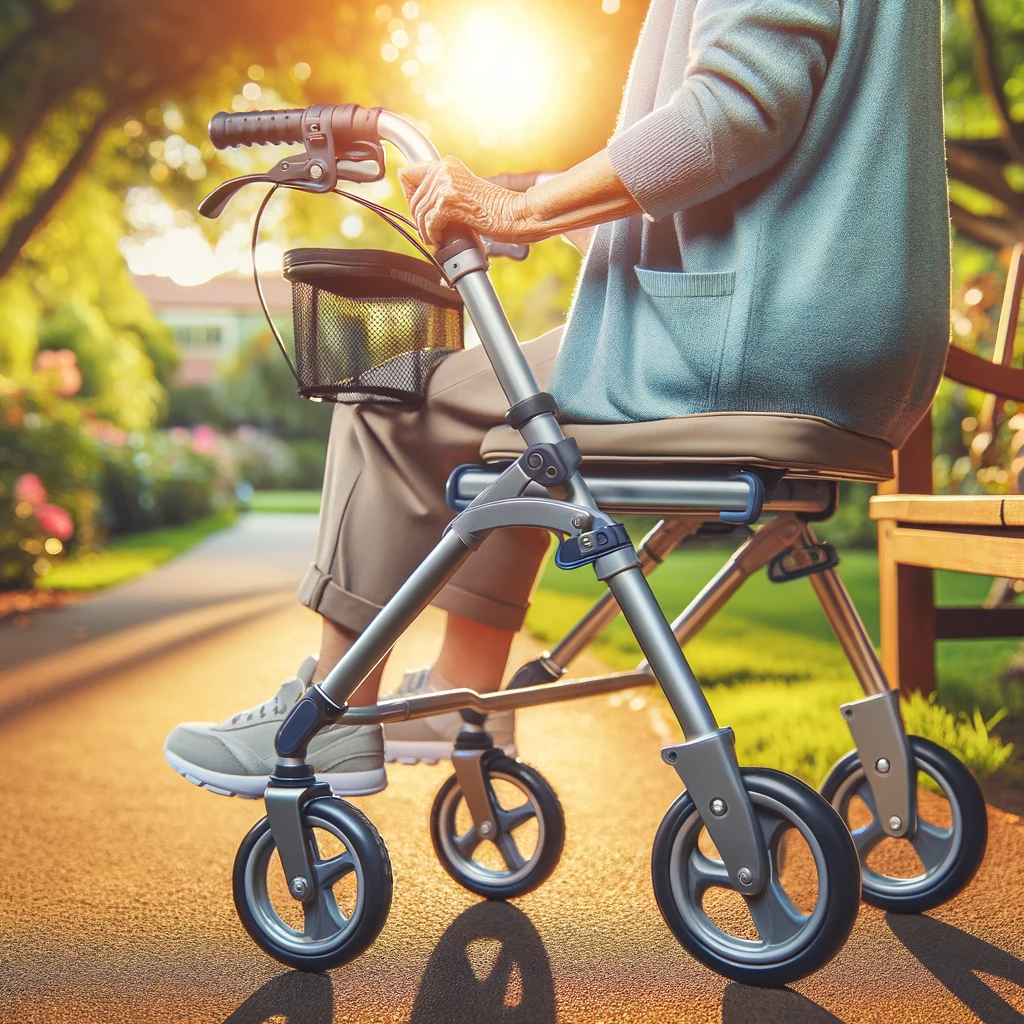Rollator Walkers vs Regular Walkers, what’s best in 2024?
Introduction to Rollator Walkers vs Regular Walkers
As we age, our mobility often changes, leading to a greater need for assistance in our daily activities. Mobility aids play a crucial role in this phase of life, especially for seniors who face challenges in walking or maintaining balance. Among the various mobility aids available, walkers stand out as popular choices due to their simplicity, effectiveness, and the independence they offer to users.
In this context, it becomes essential to understand the different types of walkers available and how they cater to diverse needs and preferences. This article focuses on two primary types of walkers used by seniors: rollator walkers and regular walkers. While they may appear similar at first glance, these two devices have distinct features, advantages, and limitations, making them suitable for different users and situations.
The purpose of this article is to provide a comprehensive comparison between rollator walkers and regular walkers. We aim to delve into their designs, functionalities, and the specific circumstances they are best suited for. This comparison will not only highlight the physical aspects of each walker but also consider the impact they have on the lifestyle and independence of senior users.
By examining these two types of walkers in detail, we seek to assist seniors, caregivers, and family members in making informed decisions about which walker would best enhance the user’s mobility and quality of life. This exploration is more than a technical review; it’s a guide to understanding how these mobility aids can play a vital role in nurturing independence and confidence among seniors, ultimately contributing to their overall well-being.

Rollator Walkers vs Regular Walkers
Mobility aids are tools designed to assist people who have difficulties moving around, enhancing their independence and quality of life. For seniors, these aids are not just about movement; they represent freedom, autonomy, and the ability to engage actively in daily life. With age, challenges like reduced muscle strength, balance issues, and joint problems become more prevalent, making mobility aids a critical aspect of senior healthcare and lifestyle management.
Definition and Importance of Mobility Aids for Seniors
Mobility aids for seniors are devices specifically designed to assist those who face challenges in walking or maintaining balance. These aids range from simple canes to more complex walkers and rollators, each catering to different levels of mobility support. They help in reducing the risk of falls, a major concern for the elderly, and aid in distributing weight to alleviate pressure on lower body joints. More than just physical support, these aids also provide psychological benefits, boosting confidence and encouraging seniors to maintain an active and social lifestyle.
Brief History of Walkers and Rollators
The history of walkers and rollators reflects the evolution of mobility aids in response to the changing needs of users. The basic form of a walker, often a simple frame with handles, dates back several decades. These were initially designed as simple, sturdy frames that a person could lean on for balance and support while walking. Over time, walkers evolved with the addition of wheels and other features to enhance mobility.
Rollators, a more recent innovation, emerged as an advancement over traditional walkers. The term “rollator,” originating from the Latin word “rollare” (to roll), was coined to describe these walkers with wheels. Invented in the 1970s by Aina Wifalk, a Swedish polio survivor, rollators were designed to offer more fluid mobility. Wifalk’s design included a built-in seat and a basket, making the rollator not just a walking aid but also a convenient tool for carrying items and resting.
This evolution from traditional walkers to rollators signifies a shift towards greater independence and ease of use in mobility aids. While traditional walkers offer stability and are easy to use, rollators provide enhanced mobility, comfort, and additional features like seats and brakes. The development of these devices has been guided by a deep understanding of the users’ needs, leading to innovations that significantly improve the quality of life for seniors.
In the next sections, we will explore the specific features, advantages, and considerations of both regular walkers and rollator walkers, offering a detailed insight into how each type supports the diverse needs of seniors.
Regular Walkers
Regular walkers, often simply referred to as “walkers,” are fundamental mobility aids used widely by seniors across the world. Understanding their design, advantages, and limitations is crucial for anyone considering a mobility aid.

Overview – Definition and Design Features
A regular walker is a frame-based mobility device that provides support for walking. Typically made of lightweight metal, such as aluminum, these walkers consist of a four-legged frame with handlebars. The user lifts the walker, places it a short distance ahead, and then steps forward to meet it, repeating this process as they move. Most standard walkers are foldable, making them convenient for storage and transport. They are also adjustable in height to cater to the user’s comfort.
Regular Walkers Advantages
Stability and Simplicity
One of the primary advantages of regular walkers is their inherent stability. The four contact points with the ground ensure a sturdy support base, making them an excellent choice for seniors who have significant balance issues or lower body weakness. This type of walker is straightforward to use, requiring minimal instruction and adjustment, which is especially beneficial for those who may be overwhelmed by more complex devices.
Cost-Effectiveness
Regular walkers are generally more affordable than rollators or other advanced mobility aids. Their simple design and the absence of mechanical parts make them less expensive to manufacture and maintain. This cost-effectiveness is a significant factor for seniors or families with budget constraints, making regular walkers a practical and accessible option.
Regular Walkers Disadvantages
Limited Mobility Support
While providing stability, regular walkers require the user to lift and move the frame with each step. This can be challenging for individuals with limited arm strength or endurance. The stop-and-start nature of walking with a standard walker can also be more tiring and less fluid compared to using a walker with wheels.
Lack of Additional Features
Regular walkers typically do not come with additional features like seats or storage. The absence of a seat means that the user cannot rest unless they find a separate place to sit. Similarly, carrying personal items may require an additional bag or pouch, which can be inconvenient and may affect the walker’s balance.
Ideal User Profile
Seniors Who Require Basic Support and Stability
Regular walkers are best suited for seniors who need substantial support for balance and stability but have sufficient upper body strength to lift and move the walker. They are particularly beneficial for those who are at a higher risk of falls and need a stable, no-frills device to aid in walking short distances, primarily indoors. Their simplicity also makes them a good choice for seniors who may find more complex aids overwhelming or difficult to use.
Rollator Walkers
Rollator walkers represent a significant advancement in mobility aids, offering enhanced features and greater comfort for seniors. Understanding their design, benefits, and potential drawbacks is essential for those considering an upgrade from a standard walker.

Overview – Definition and Design Innovations
Rollator walkers, often simply called “rollators,” are advanced walking aids equipped with wheels on all legs. This design allows the user to simply push the walker ahead, rather than lifting it. Most rollators come with three or four wheels, handlebars with grips, and a braking system similar to that on a bicycle. They often include a seat for resting and a basket or pouch for personal items. The design innovations in rollators focus on ease of mobility and user comfort, accommodating a more active lifestyle.
Rollator Walkers Advantages
Enhanced Mobility and Comfort
The most significant advantage of a rollator is its ability to enhance mobility. The wheels allow for a smoother movement, reducing the effort required to move around. This can be especially beneficial for seniors who have the strength and balance to walk but tire easily from lifting a standard walker. The inclusion of a seat provides a convenient resting spot, enabling users to take breaks as needed, which is particularly advantageous during long outings or walks.
Additional Features: Seats, Brakes, Storage
Rollators are equipped with various additional features that increase their functionality. The seats offer a comfortable and safe place to rest, reducing the risk of fatigue. Brakes provide added safety, allowing users to control the speed of the rollator and secure it in place when sitting. Storage options, such as baskets or pouches, make it easier for users to carry personal items, enhancing their independence when running errands or traveling.
Rollator Walkers Disadvantages
Higher Cost
With advanced features comes a higher price tag. Rollators are typically more expensive than standard walkers due to their more complex design and added components. This cost factor can be a consideration for those on a tight budget.
Requires More Physical Control
While rollators offer enhanced mobility, they also require the user to have a certain level of physical control and coordination. Managing the speed and direction, especially on uneven surfaces or slopes, can be challenging for some users. The need to engage brakes can also be a factor for those with limited hand strength or arthritis.
Rollator Walkers Ideal User Profile
Seniors Seeking Greater Mobility and Independence
Rollator walkers are ideal for seniors who desire more mobility and independence than what a standard walker offers. They are best suited for those who can walk but need assistance with balance and endurance. Rollators are particularly beneficial for active seniors who enjoy going outdoors, shopping, or engaging in social activities, as they provide the necessary support while also offering the flexibility and features to facilitate a more active lifestyle.
Comparative Analysis of Rollator Walkers vs Regular Walkers
When choosing between a rollator walker and a regular walker, understanding the differences in stability, support, usability, comfort, cost, and maintenance is crucial. This comparative analysis aims to provide clear insights into these aspects, helping seniors and their caregivers make informed decisions.

Stability and Support
Comparison of Stability and Support Offered by Both Types
Regular walkers offer superior stability due to their four-point structure that firmly contacts the ground. This design is particularly beneficial for those with significant balance issues or weakness in the lower body. However, the support offered by regular walkers is more passive, requiring the user to lift and move the walker for each step.
Rollators, on the other hand, provide dynamic support. Their wheeled design allows for continuous movement, making them less stable than regular walkers but offering better support for those who can maintain balance while moving. The handles and adjustable height also contribute to a supportive walking experience, though they require more user control.
Usability and Comfort
Ease of Use in Different Environments
Regular walkers are highly effective indoors, especially in confined spaces where their stability and compact size are advantageous. However, their utility diminishes outdoors or over uneven terrain due to the need for lifting and moving the frame.
Rollators excel in a variety of environments, including outdoors. The wheels make maneuvering over different terrains easier, and the built-in brakes add safety on slopes and uneven surfaces. This makes rollators a preferred choice for seniors who are more active and spend time outside.
Comfort Features for Prolonged Use
Comfort is a significant factor, especially for prolonged use. Regular walkers lack built-in seats and storage, which can be limiting for users who need to rest or carry personal items. Rollators, with their padded seats and storage options, provide greater comfort and convenience, allowing users to take breaks and store belongings easily.
Cost and Maintenance
Initial Cost Comparison
The initial cost of regular walkers is generally lower than that of rollators. This cost-effectiveness makes regular walkers a more accessible option for those on a tight budget or who require a walker for short-term use.
Rollators, given their advanced features and materials, tend to be more expensive. The additional cost is justified by the enhanced mobility, comfort features, and overall utility, especially for long-term use.
Long-term Maintenance and Durability
In terms of maintenance and durability, regular walkers are simpler and have fewer components that could require repair or replacement. Their basic frame design ensures longevity with minimal maintenance.
Rollators, with their moving parts, brakes, and sometimes complex frames, may require more maintenance over time. The wheels and brake systems, in particular, need regular checks and potential replacements to ensure safety and functionality.
In conclusion, the choice between a regular walker and a rollator depends largely on the user’s specific needs, lifestyle, and budget. Regular walkers are ideal for those who need stable support and have a limited budget, while rollators are suited for more active seniors who require mobility and comfort in various environments. Understanding these differences enables users to choose a mobility aid that best aligns with their individual requirements.
Expert Opinions
Gaining insights from medical professionals and physical therapists is invaluable when choosing the right mobility aid. Their expertise helps ensure that the choice aligns with the user’s health, physical capabilities, and lifestyle needs.
Medical Professionals’ Recommendations
Medical professionals often recommend regular walkers for seniors with significant stability issues, particularly those recovering from surgery or with severe joint problems. They emphasize the walker’s ability to provide a stable support system, reducing the risk of falls and injuries. For seniors with cardiovascular concerns or those who require a less strenuous option, rollators are often suggested due to their ease of movement and reduced physical strain.
Physical Therapists’ Insights on Choosing the Right Mobility Aid
Physical therapists stress the importance of assessing the individual’s physical strength, balance, and endurance. They advise that for those with sufficient upper body strength and moderate balance control, a regular walker could be more beneficial. However, for seniors who are more active and have better control over their movements, rollators are recommended for their flexibility and ease of use in various settings. Therapists also highlight the importance of adjustable features and ergonomics to ensure the mobility aid is tailored to the user’s specific needs.
Conclusion of Rollator Walkers vs Regular Walkers
Summary of Key Points
In summary, both regular walkers and rollators offer distinct benefits for seniors requiring mobility assistance. Regular walkers provide stability and are cost-effective, making them suitable for those who need basic support and have a limited budget. Rollators, with their advanced features such as wheels, brakes, and seats, offer enhanced mobility and comfort, catering to more active seniors.
Final Recommendations Based on Specific Needs and Lifestyles
The choice between a regular walker and a rollator should be based on the user’s physical abilities, lifestyle, and personal preferences. For seniors who need stable support for indoor use and have a limited budget, regular walkers are ideal. Rollators are better suited for those who seek greater mobility and independence, and who are active both indoors and outdoors.
Additional Resources for Rollator Walkers vs Regular Walkers
Links to Further Reading
For more in-depth information, seniors and caregivers can explore resources like:
- The National Institute on Aging (NIA) website for articles on mobility aids.
- The Arthritis Foundation for tips on choosing walkers for arthritis patients.
See our other article on walkers!
Upright Walkers for Seniors #1 Guide
Upright Walkers for Seniors – 2024 Best 5 Review
Best Walkers for Seniors on a Budget
Rollator Walkers vs Regular Walkers, what’s best in 2024?
Walkers for Adults: Great Mobility in 2024
Walkers for Seniors: Our Complete Guide
Three Wheel Walker: #1 Best Picks & Buying Tips for Seniors
Drive Walker with Seat for Seniors – Top 5 in 2024
Upright Walkers for Seniors – 2024 Best 5 Review
JustforSeniors.org – Health & Wellness

